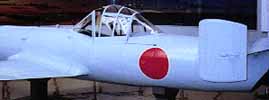
Yushukan Museum, Harajuka and ShibuyaAfter Toko Hotel checkout, I rode up to Shibuya station since the evening's hotel was near there. While stowing my gear in a coin locker I sensed my trip unraveling as my trousers split, a seam near the crotch giving way as I bent over. Nothing to do but retreat into a smelly public toilet stall with my sewing kit and effect a repair, leaning against the wall while working with thread and needle over the trough-like Japanese toilet. Not bad though, didn't take long; and it held for the duration.
From there my destination was the Yasukuni Shrine and
adjacent Yushukan Museum at the northern edge of
the park surrounding the Imperial Compound (what
used to be the castle, the moat's still there). It's
hard to find information about this museum in the
conventional literature, the shrine is to the War
Dead and it's somewhat controversial because it's
one of the things critics point to when they claim
the Japanese don't have requisite remorse, like
the Germans display about World War II. So
naturally I've been curious; the shrine was just a
shrine (like most of those big ones I saw, there
was a display of chrysanthemums, since it was that
season) but the museum had some really interesting
stuff. It's been there for a while; one room had
photos and paintings of state visits by the four
modern emperors. The main draw (for me) was the
Jinrai Butai or "Divine Thunderbolt" material.
There's a kamikaze plane in the main hall:
Exhibits for other suicide attack methods were also on display, these were new to me: the human torpedo, or one-man submarine bomb - they had a large example, on loan from a U.S. Army museum in Hawaii, and some smaller models of similar vessels; a big painting of a related idea developed in surface boats and the weirdest of all, a mannequin in a deep-sea diver suit (wearing a square helmet) brandishing a long bamboo pole with an explosive canister at the end. Fukuryu (crouching dragons) of the Special Attack Corps were expected to wade out into harbors and sink enemy ships floating in shallow waters by sticking 'em with their pole-bombs. This method didn't prove to be successful; big losses incurred during testing caused that particular program's cancellation.
After inspecting all the museum had to offer
I left the park and had a late lunch during which I
finished reading the Memoirs of a Geisha
book - this was at a curry restaurant called
B&S (part of chain, like the nearby Pot &
Pot, across the street from the Freshness Burger).
Afterwards, strolled over to the Ichigaya station
to catch a Chou line train over to Harajuka.
It was getting dark when I got back to Shibuya - before retrieving my luggage I had some sushi at my favorite mechanical sushi bar. Always a little difficult to locate, I like it because the conveyer belt doesn't travel in the usual rectangle, but rather a convoluted "L" shape. It's usually so crowded that to meet demand the sushi guys are adding so many of the little dishes that they feather them into what's there, and sometimes these fall off with a clatter as the belt moves around its corners. The white-tile walls add to the atmosphere I characterize as proletarian; or used to - guess business has been good for them because the ambience has gotten a little upscale - a lot more wood has been added to the decor, the counters are now marble and one of those additional sub-belts have been added, which carry empty tea-mugs at a much slower speed under the main conveyor. The customer fills these from the recently-added spigots which issue boiling water (placed at regular intervals like the square tubs full of sliced, pickled gari ginger and green tea-bags on the counter). Afterwards, outside, I rode a bus up the hill to locate my hotel for the night. This was the Fukudaya, a place I got a reservation and map for at the TIC. Family run like a minshuku and quite reasonable, quiet even though it's just off a major boulevard (the multi-level National Road), I was compelled to remove my shoes at the door - unusual for a business hotel. Since this one features more Japanese-style room than the two Western-style ones I occupied on the third (top) floor, that's understandable. Back outside I walked down the hill, eventually discovering that I'd gotten turned around and was heading away from Shibuya; walked back up the hill and then down it the right way, at one point passing a homeless person setting up camp with his cardboard boxes in an underground passageway, and when I surfaced, marveling at the beautiful animated blue neon signage mounted on the surrounding office building rooftops. Eventually I found myself in the throngs surging around the noisy bustle of the heart of Shibuya night action around the station. Adding to the "Blade Runner" ambiance was the anachronistic presence of this '61 Chevy Impala convertible, snapped while waiting for the lights to change. Nearby, I
watched a guy with a little stand selling Rolex
copy-watches, marked up a $100 or so from the
price he probably paid for them on the streets
of Hong Kong; and a branch of Baskin-Robbins
where I had a very tasty Musk Melon ice cream
cone.
while waiting for the lights to change. Nearby, I
watched a guy with a little stand selling Rolex
copy-watches, marked up a $100 or so from the
price he probably paid for them on the streets
of Hong Kong; and a branch of Baskin-Robbins
where I had a very tasty Musk Melon ice cream
cone.
Next: Kamakura |


